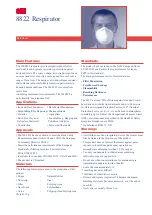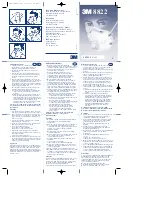
6
ELSA 2000 Issue N
Owing to its weight, the 3 litre ELSA is not
suitable for wearing for complete 8 hour
shifts.
Pictogram user instructions and the
duration of the air supply are prominently
visible on the bag.
Two bright red anti-tamper tags seal the
bag. The tags break easily when the bag
is opened, or if the apparatus is tampered
with.
The combined reducer/cylinder valve
(RCV) is held closed by a firing pin, which
is attached to the bag’s flap by a quick-
fire strap. When the access flap is opened
it pulls the pin and opens the valve. Air
immediately flows into the hood.
If the firing pin is not released when the
bag is opened the quick-fire strap can
be used to pull it. The red EMERGENCY
PULL disc on the RCV can be used to pull
the valve actuator once the firing pin has
been released.
While ELSA is stored ready for use,
the cylinder contents gauge, on the
cylinder/reducer valve, is visible though a
transparent panel in the bag, permitting
the cylinder charge state to be checked
without opening the bag.
Providing the apparatus is serviced
regularly in accordance with the service
requirements detailed in the ELSA Service
Manual, there are no shelf life limits.
ELSA should be stored away from direct
heat and sunlight, and operated between
-15°C and +60°C. Prior to storing in very
low temperatures the apparatus, especially
the valve flaps, must be completely dry.
HOOD
The hood is fabricated in high-visibility,
flame-resistant PVC or PVC coated
materials with a rubber neck seal.
An inner mask, which covers the wearer’s
nose and mouth, minimises visor misting
and carbon dioxide dead space.
Sprung metal strips hold the visor flat
when in storage.
When in use, form the hood to a shape
that holds the inner mask against the
wearer’s face.
A sealed foam pad on the inner rear of the
hood holds the hood in place when the
wearer’s head moves.
The spring-loaded exhale valve helps
maintain an above ambient pressure
within the hood.
REDUCER/CYLINDER VALVE
The reducer/cylinder valve (RCV) is
screwed permanently into the cylinder. It
is a spring and piston device with a fixed
orifice outlet. The cylinder valve opens
automatically when the firing pin is pulled,
permitting air to flow from the reducer to
the hood.
The quick-fire strap can be used to pull
the firing pin in the unlikely event of the
pin not releasing when the bag is opened.
The red EMERGENCY PULL disc on the
RCV can be used to pull the valve actuator
once the firing pin has been released.
The warning whistle sounds when the
designed duration (10 or 15 minutes) is
reached. Beyond this point the carbon
dioxide level in the hood increases and
the hood must be removed as soon as the
wearer is clear of the hazard area.
The medium-pressure system is protected
from over-pressurisation by a pressure
relief valve (PRV) located in the reducer.
The contents gauge indicates the cylinder
charge level, which must be maintained at
fully-charged with the needle in the green
sector of the gauge.
The orange sector of the gauge indicates
the minimum cylinder charge that will
achieve the specified duration. This is NOT
an acceptable charge state for issued or
ready-use apparatus.
The charging adaptor conforms to EN
144-2:1996.



























